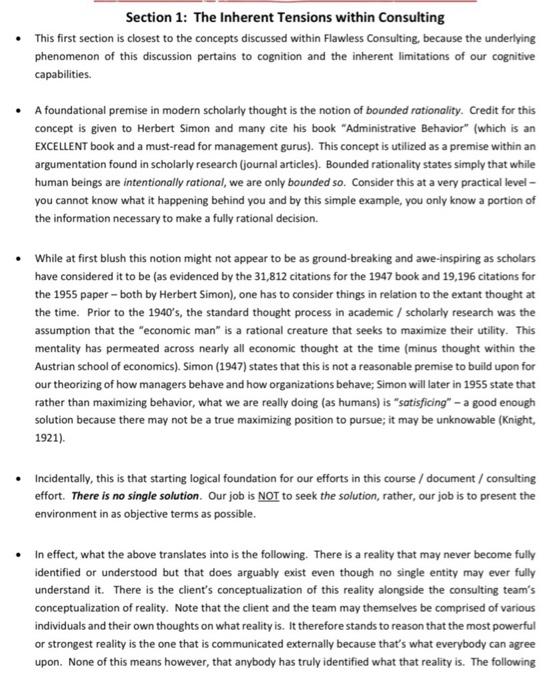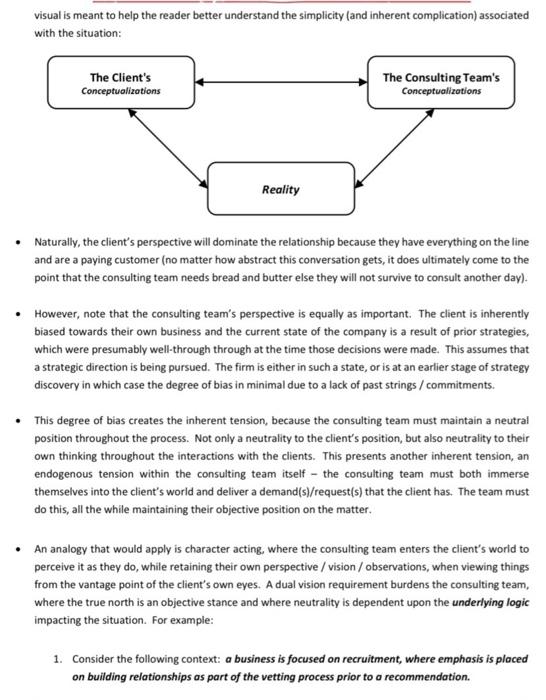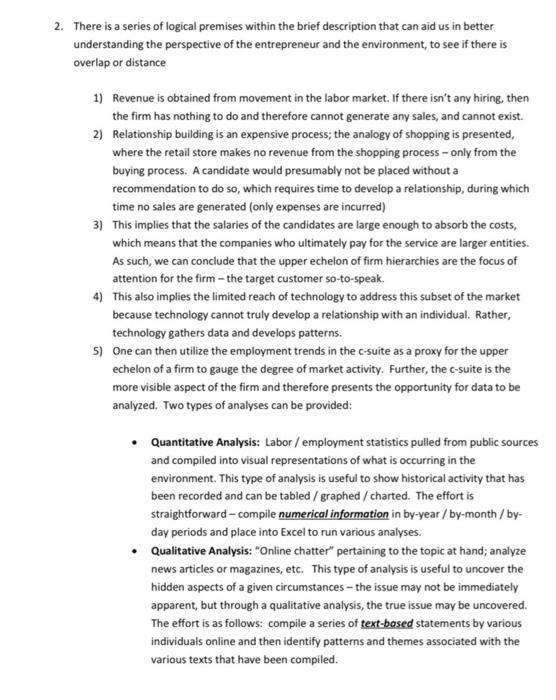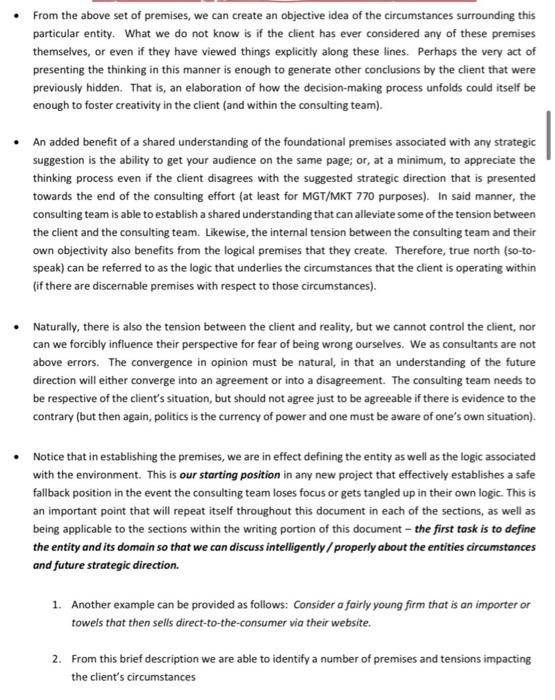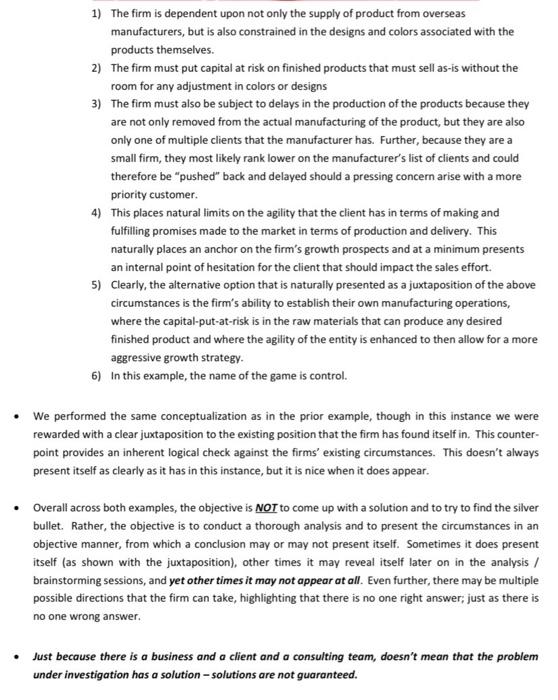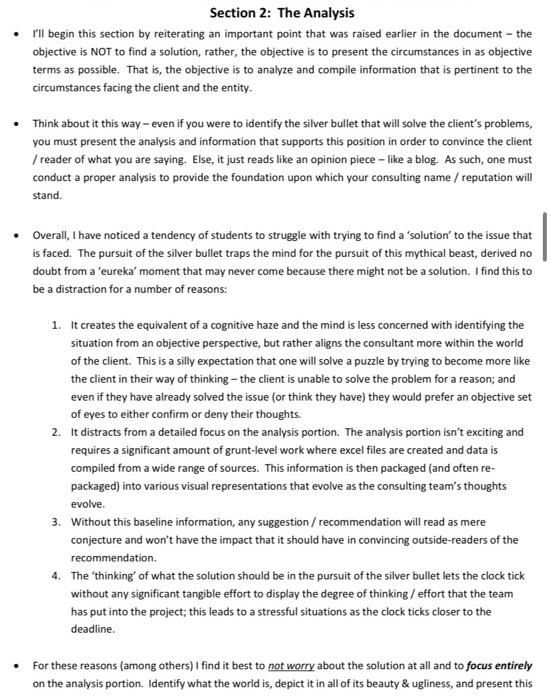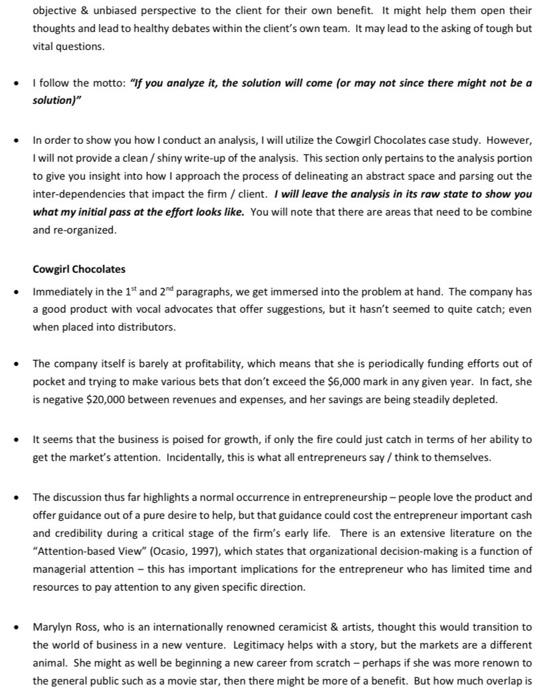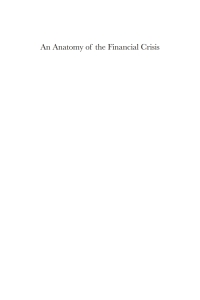answer the two questions:
(A) Please indicate one or two aspects that resonated with you about the document.
(B) Please indicate what didnt resonate with you or that you disagree with
Section 1: The Inherent Tensions within Consulting This first section is closest to the concepts discussed within Flawless Consulting, because the underlying phenomenon of this discussion pertains to cognition and the inherent limitations of our cognitive capabilities. A foundational premise in modern scholarly thought is the notion of bounded rationality. Credit for this concept is given to Herbert Simon and many cite his book "Administrative Behavior" (which is an EXCELLENT book and a must-read for management gurus). This concept is utilized as a premise within an argumentation found in scholarly research (journal articles). Bounded rationality states simply that while human beings are intentionally rational, we are only bounded so. Consider this at a very practical level you cannot know what it happening behind you and by this simple example, you only know a portion of the information necessary to make a fully rational decision While at first blush this notion might not appear to be as ground-breaking and awe-inspiring as scholars have considered it to be (as evidenced by the 31,812 citations for the 1947 book and 19,196 citations for the 1955 paper - both by Herbert Simon), one has to consider things in relation to the extant thought at the time. Prior to the 1940's, the standard thought process in academic / scholarly research was the assumption that the "economic man" is a rational creature that seeks to maximize their utility. This mentality has permeated across nearly all economic thought at the time (minus thought within the Austrian school of economics). Simon (1947) states that this is not a reasonable premise to build upon for our theorizing of how managers behave and how organizations behave; Simon will later in 1955 state that rather than maximizing behavior, what we are really doing (as humans) is "satisficing" - a good enough solution because there may not be a true maximizing position to pursue; it may be unknowable (Knight, 1921). Incidentally, this is that starting logical foundation for our efforts in this course / document / consulting effort. There is no single solution. Our job is NOT to seek the solution, rather, our job is to present the environment in as objective terms as possible. In effect, what the above translates into is the following. There is a reality that may never become fully identified or understood but that does arguably exist even though no single entity may ever fully understand it. There is the client's conceptualization of this reality alongside the consulting team's conceptualization of reality. Note that the client and the team may themselves be comprised of various individuals and their own thoughts on what reality is. It therefore stands to reason that the most powerful or strongest reality is the one that is communicated externally because that's what everybody can agree upon. None of this means however, that anybody has truly identified what that reality is. The following visual is meant to help the reader better understand the simplicity (and inherent complication) associated with the situation: The Client's Conceptualizations The Consulting Team's Conceptualizations Reality Naturally, the client's perspective will dominate the relationship because they have everything on the line and are a paying customer (no matter how abstract this conversation gets, it does ultimately come to the point that the consulting team needs bread and butter else they will not survive to consult another day). However, note that the consulting team's perspective is equally as important. The client is inherently biased towards their own business and the current state of the company is a result of prior strategies, which were presumably well-through through at the time those decisions were made. This assumes that a strategic direction is being pursued. The firm is either in such a state, or is at an earlier stage of strategy discovery in which case the degree of bias in minimal due to a lack of past strings / commitments. This degree of bias creates the inherent tension, because the consulting team must maintain a neutral position throughout the process. Not only a neutrality to the client's position, but also neutrality to their own thinking throughout the interactions with the clients. This presents another inherent tension, an endogenous tension within the consulting team itself - the consulting team must both immerse themselves into the client's world and deliver a demand(s)/request(s) that the client has. The team must do this, all the while maintaining their objective position on the matter. An analogy that would apply is character acting, where the consulting team enters the client's world to perceive it as they do, while retaining their own perspective / vision / observations, when viewing things from the vantage point of the client's own eyes. A dual vision requirement burdens the consulting team, where the true north is an objective stance and where neutrality is dependent upon the underlying logic impacting the situation. For example: 1. Consider the following context: a business is focused on recruitment, where emphasis is placed on building relationships as part of the vetting process prior to a recommendation. 2. There is a series of logical premises within the brief description that can aid us in better understanding the perspective of the entrepreneur and the environment, to see if there is overlap or distance 1) Revenue is obtained from movement in the labor market. If there isn't any hiring, then the firm has nothing to do and therefore cannot generate any sales, and cannot exist. 2) Relationship building is an expensive process; the analogy of shopping is presented, where the retail store makes no revenue from the shopping process - only from the buying process. A candidate would presumably not be placed without a recommendation to do so, which requires time to develop a relationship, during which time no sales are generated (only expenses are incurred) 3) This implies that the salaries of the candidates are large enough to absorb the costs, which means that the companies who ultimately pay for the service are larger entities. As such, we can conclude that the upper echelon of firm hierarchies are the focus of attention for the firm - the target customer so-to-speak. 4) This also implies the limited reach of technology to address this subset of the market because technology cannot truly develop a relationship with an individual. Rather, technology gathers data and develops patterns. 5) One can then utilize the employment trends in the c-suite as a proxy for the upper echelon of a firm to gauge the degree of market activity. Further, the c-suite is the more visible aspect of the firm and therefore presents the opportunity for data to be analyzed. Two types of analyses can be provided Quantitative Analysis: Labor / employment statistics pulled from public sources and compiled into visual representations of what is occurring in the environment. This type of analysis is useful to show historical activity that has been recorded and can be tabled/graphed / charted. The effort is straightforward - compile numerical information in by-year / by-month / by- day periods and place into Excel to run various analyses. Qualitative Analysis: "Online chatter" pertaining to the topic at hand; analyze news articles or magazines, etc. This type of analysis is useful to uncover the hidden aspects of a given circumstances - the issue may not be immediately apparent, but through a qualitative analysis, the true issue may be uncovered. The effort is as follows: compile a series of text-based statements by various individuals online and then identify patterns and themes associated with the various texts that have been compiled. From the above set of premises, we can create an objective idea of the circumstances surrounding this particular entity. What we do not know is if the client has ever considered any of these premises themselves, or even if they have viewed things explicitly along these lines. Perhaps the very act of presenting the thinking in this manner is enough to generate other conclusions by the client that were previously hidden. That is, an elaboration of how the decision-making process unfolds could itself be enough to foster creativity in the client (and within the consulting team). An added benefit of a shared understanding of the foundational premises associated with any strategic suggestion is the ability to get your audience on the same page; or, at a minimum, to appreciate the thinking process even if the client disagrees with the suggested strategic direction that is presented towards the end of the consulting effort (at least for MGT/MKT 770 purposes). In said manner, the consulting team is able to establish a shared understanding that can alleviate some of the tension between the client and the consulting team. Likewise, the internal tension between the consulting team and their own objectivity also benefits from the logical premises that they create. Therefore, true north (so-to- speak) can be referred to as the logic that underlies the circumstances that the client is operating within (if there are discernable premises with respect to those circumstances). Naturally, there is also the tension between the client and reality, but we cannot control the client, nor can we forcibly influence their perspective for fear of being wrong ourselves. We as consultants are not above errors. The convergence in opinion must be natural, in that an understanding of the future direction will either converge into an agreement or into a disagreement. The consulting team needs to be respective of the client's situation, but should not agree just to be agreeable if there is evidence to the contrary (but then again, politics is the currency of power and one must be aware of one's own situation). Notice that in establishing the premises, we are in effect defining the entity as well as the logic associated with the environment. This is our starting position in any new project that effectively establishes a safe fallback position in the event the consulting team loses focus or gets tangled up in their own logic. This is an important point that will repeat itself throughout this document in each of the sections, as well as being applicable to the sections within the writing portion of this document - the first task is to define the entity and its domain so that we can discuss intelligently / properly about the entities circumstances and future strategic direction. 1. Another example can be provided as follows: Consider a fairly young firm that is an importer or towels that then sells direct-to-the-consumer via their website. 2. From this brief description we are able to identify a number of premises and tensions impacting the client's circumstances 1) The firm is dependent upon not only the supply of product from overseas manufacturers, but is also constrained in the designs and colors associated with the products themselves. 2) The firm must put capital at risk on finished products that must sell as-is without the room for any adjustment in colors or designs 3) The firm must also be subject to delays in the production of the products because they are not only removed from the actual manufacturing of the product, but they are also only one of multiple clients that the manufacturer has. Further, because they are a small firm, they most likely rank lower on the manufacturer's list of clients and could therefore be "pushed" back and delayed should a pressing concern arise with a more priority customer. 4) This places natural limits on the agility that the client has in terms of making and fulfilling promises made to the market in terms of production and delivery. This naturally places an anchor on the firm's growth prospects and at a minimum presents an internal point of hesitation for the client that should impact the sales effort. 5) Clearly, the alternative option that is naturally presented as a juxtaposition of the above circumstances is the firm's ability to establish their own manufacturing operations, where the capital-put-at-risk is in the raw materials that can produce any desired finished product and where the agility of the entity is enhanced to then allow for a more aggressive growth strategy. 6) In this example, the name of the game is control. We performed the same conceptualization as in the prior example, though in this instance we were rewarded with a clear juxtaposition to the existing position that the firm has found itself in. This counter- point provides an inherent logical check against the firms' existing circumstances. This doesn't always present itself as clearly as it has in this instance, but it is nice when it does appear. Overall across both examples, the objective is NOT to come up with a solution and to try to find the silver bullet. Rather, the objective is to conduct a thorough analysis and to present the circumstances in an objective manner, from which a conclusion may or may not present itself. Sometimes it does present itself (as shown with the juxtaposition), other times it may reveal itself later on in the analysis / brainstorming sessions, and yet other times it may not appear at all. Even further, there may be multiple possible directions that the firm can take, highlighting that there is no one right answer, just as there is no one wrong answer. . Just because there is a business and a client and a consulting team, doesn't mean that the problem under investigation has a solution-solutions are not guaranteed. Section 2: The Analysis I'll begin this section by reiterating an important point that was raised earlier in the document - the objective is NOT to find a solution, rather, the objective is to present the circumstances in as objective terms as possible. That is, the objective is to analyze and compile information that is pertinent to the circumstances facing the client and the entity. Think about it this way - even if you were to identify the silver bullet that will solve the client's problems, you must present the analysis and information that supports this position in order to convince the client /reader of what you are saying. Else, it just reads like an opinion piece - like a blog. As such, one must conduct a proper analysis to provide the foundation upon which your consulting name / reputation will stand. Overall, I have noticed a tendency of students to struggle with trying to find a solution' to the issue that is faced. The pursuit of the silver bullet traps the mind for the pursuit of this mythical beast, derived no doubt from a 'eureka' moment that may never come because there might not be a solution. I find this to be a distraction for a number of reasons: 1. It creates the equivalent of a cognitive haze and the mind is less concerned with identifying the situation from an objective perspective, but rather aligns the consultant more within the world of the client. This is a silly expectation that one will solve a puzzle by trying to become more like the client in their way of thinking - the client is unable to solve the problem for a reason; and even if they have already solved the issue (or think they have) they would prefer an objective set of eyes to either confirm or deny their thoughts. 2. It distracts from a detailed focus on the analysis portion. The analysis portion isn't exciting and requires a significant amount of grunt-level work where excel files are created and data is compiled from a wide range of sources. This information is then packaged (and often re- packaged) into various visual representations that evolve as the consulting team's thoughts evolve. 3. Without this baseline information, any suggestion / recommendation will read as mere conjecture and won't have the impact that it should have in convincing outside-readers of the recommendation. 4. The thinking of what the solution should be in the pursuit of the silver bullet lets the clock tick without any significant tangible effort to display the degree of thinking/effort that the team has put into the project; this leads to a stressful situations as the clock ticks closer to the deadline For these reasons (among others) I find it best to not worry about the solution at all and to focus entirely on the analysis portion. Identify what the world is, depict it in all of its beauty & ugliness, and present this objective & unbiased perspective to the client for their own benefit. It might help them open their thoughts and lead to healthy debates within the client's own team. It may lead to the asking of tough but vital questions I follow the motto: "If you analyze it, the solution will come for may not since there might not be a solution)" In order to show you how I conduct an analysis, I will utilize the Cowgirl Chocolates case study. However, I will not provide a clean / shiny write-up of the analysis. This section only pertains to the analysis portion to give you insight into how I approach the process of delineating an abstract space and parsing out the inter-dependencies that impact the firm / client. I will leave the analysis in its raw state to show you what my initial pass at the effort looks like. You will note that there are areas that need to be combine and re-organized Cowgirl Chocolates Immediately in the 1" and 2 paragraphs, we get immersed into the problem at hand. The company has a good product with vocal advocates that offer suggestions, but it hasn't seemed to quite catch; even when placed into distributors. The company itself is barely at profitability, which means that she is periodically funding efforts out of pocket and trying to make various bets that don't exceed the $6,000 mark in any given year. In fact, she is negative $20,000 between revenues and expenses, and her savings are being steadily depleted. It seems that the business is poised for growth, if only the fire could just catch in terms of her ability to get the market's attention. Incidentally, this is what all entrepreneurs say / think to themselves. The discussion thus far highlights a normal occurrence in entrepreneurship- people love the product and offer guidance out of a pure desire to help, but that guidance could cost the entrepreneur important cash and credibility during a critical stage of the firm's early life. There is an extensive literature on the "Attention-based View" (Ocasio, 1997), which states that organizational decision-making is a function of managerial attention - this has important implications for the entrepreneur who has limited time and resources to pay attention to any given specific direction. Marylyn Ross, who is an internationally renowned ceramicist & artists, thought this would transition to the world of business in a new venture. Legitimacy helps with a story, but the markets are a different animal. She might as well be beginning a new career from scratch - perhaps if she was more renown to the general public such as a movie star, then there might be more of a benefit. But how much overlap is Section 1: The Inherent Tensions within Consulting This first section is closest to the concepts discussed within Flawless Consulting, because the underlying phenomenon of this discussion pertains to cognition and the inherent limitations of our cognitive capabilities. A foundational premise in modern scholarly thought is the notion of bounded rationality. Credit for this concept is given to Herbert Simon and many cite his book "Administrative Behavior" (which is an EXCELLENT book and a must-read for management gurus). This concept is utilized as a premise within an argumentation found in scholarly research (journal articles). Bounded rationality states simply that while human beings are intentionally rational, we are only bounded so. Consider this at a very practical level you cannot know what it happening behind you and by this simple example, you only know a portion of the information necessary to make a fully rational decision While at first blush this notion might not appear to be as ground-breaking and awe-inspiring as scholars have considered it to be (as evidenced by the 31,812 citations for the 1947 book and 19,196 citations for the 1955 paper - both by Herbert Simon), one has to consider things in relation to the extant thought at the time. Prior to the 1940's, the standard thought process in academic / scholarly research was the assumption that the "economic man" is a rational creature that seeks to maximize their utility. This mentality has permeated across nearly all economic thought at the time (minus thought within the Austrian school of economics). Simon (1947) states that this is not a reasonable premise to build upon for our theorizing of how managers behave and how organizations behave; Simon will later in 1955 state that rather than maximizing behavior, what we are really doing (as humans) is "satisficing" - a good enough solution because there may not be a true maximizing position to pursue; it may be unknowable (Knight, 1921). Incidentally, this is that starting logical foundation for our efforts in this course / document / consulting effort. There is no single solution. Our job is NOT to seek the solution, rather, our job is to present the environment in as objective terms as possible. In effect, what the above translates into is the following. There is a reality that may never become fully identified or understood but that does arguably exist even though no single entity may ever fully understand it. There is the client's conceptualization of this reality alongside the consulting team's conceptualization of reality. Note that the client and the team may themselves be comprised of various individuals and their own thoughts on what reality is. It therefore stands to reason that the most powerful or strongest reality is the one that is communicated externally because that's what everybody can agree upon. None of this means however, that anybody has truly identified what that reality is. The following visual is meant to help the reader better understand the simplicity (and inherent complication) associated with the situation: The Client's Conceptualizations The Consulting Team's Conceptualizations Reality Naturally, the client's perspective will dominate the relationship because they have everything on the line and are a paying customer (no matter how abstract this conversation gets, it does ultimately come to the point that the consulting team needs bread and butter else they will not survive to consult another day). However, note that the consulting team's perspective is equally as important. The client is inherently biased towards their own business and the current state of the company is a result of prior strategies, which were presumably well-through through at the time those decisions were made. This assumes that a strategic direction is being pursued. The firm is either in such a state, or is at an earlier stage of strategy discovery in which case the degree of bias in minimal due to a lack of past strings / commitments. This degree of bias creates the inherent tension, because the consulting team must maintain a neutral position throughout the process. Not only a neutrality to the client's position, but also neutrality to their own thinking throughout the interactions with the clients. This presents another inherent tension, an endogenous tension within the consulting team itself - the consulting team must both immerse themselves into the client's world and deliver a demand(s)/request(s) that the client has. The team must do this, all the while maintaining their objective position on the matter. An analogy that would apply is character acting, where the consulting team enters the client's world to perceive it as they do, while retaining their own perspective / vision / observations, when viewing things from the vantage point of the client's own eyes. A dual vision requirement burdens the consulting team, where the true north is an objective stance and where neutrality is dependent upon the underlying logic impacting the situation. For example: 1. Consider the following context: a business is focused on recruitment, where emphasis is placed on building relationships as part of the vetting process prior to a recommendation. 2. There is a series of logical premises within the brief description that can aid us in better understanding the perspective of the entrepreneur and the environment, to see if there is overlap or distance 1) Revenue is obtained from movement in the labor market. If there isn't any hiring, then the firm has nothing to do and therefore cannot generate any sales, and cannot exist. 2) Relationship building is an expensive process; the analogy of shopping is presented, where the retail store makes no revenue from the shopping process - only from the buying process. A candidate would presumably not be placed without a recommendation to do so, which requires time to develop a relationship, during which time no sales are generated (only expenses are incurred) 3) This implies that the salaries of the candidates are large enough to absorb the costs, which means that the companies who ultimately pay for the service are larger entities. As such, we can conclude that the upper echelon of firm hierarchies are the focus of attention for the firm - the target customer so-to-speak. 4) This also implies the limited reach of technology to address this subset of the market because technology cannot truly develop a relationship with an individual. Rather, technology gathers data and develops patterns. 5) One can then utilize the employment trends in the c-suite as a proxy for the upper echelon of a firm to gauge the degree of market activity. Further, the c-suite is the more visible aspect of the firm and therefore presents the opportunity for data to be analyzed. Two types of analyses can be provided Quantitative Analysis: Labor / employment statistics pulled from public sources and compiled into visual representations of what is occurring in the environment. This type of analysis is useful to show historical activity that has been recorded and can be tabled/graphed / charted. The effort is straightforward - compile numerical information in by-year / by-month / by- day periods and place into Excel to run various analyses. Qualitative Analysis: "Online chatter" pertaining to the topic at hand; analyze news articles or magazines, etc. This type of analysis is useful to uncover the hidden aspects of a given circumstances - the issue may not be immediately apparent, but through a qualitative analysis, the true issue may be uncovered. The effort is as follows: compile a series of text-based statements by various individuals online and then identify patterns and themes associated with the various texts that have been compiled. From the above set of premises, we can create an objective idea of the circumstances surrounding this particular entity. What we do not know is if the client has ever considered any of these premises themselves, or even if they have viewed things explicitly along these lines. Perhaps the very act of presenting the thinking in this manner is enough to generate other conclusions by the client that were previously hidden. That is, an elaboration of how the decision-making process unfolds could itself be enough to foster creativity in the client (and within the consulting team). An added benefit of a shared understanding of the foundational premises associated with any strategic suggestion is the ability to get your audience on the same page; or, at a minimum, to appreciate the thinking process even if the client disagrees with the suggested strategic direction that is presented towards the end of the consulting effort (at least for MGT/MKT 770 purposes). In said manner, the consulting team is able to establish a shared understanding that can alleviate some of the tension between the client and the consulting team. Likewise, the internal tension between the consulting team and their own objectivity also benefits from the logical premises that they create. Therefore, true north (so-to- speak) can be referred to as the logic that underlies the circumstances that the client is operating within (if there are discernable premises with respect to those circumstances). Naturally, there is also the tension between the client and reality, but we cannot control the client, nor can we forcibly influence their perspective for fear of being wrong ourselves. We as consultants are not above errors. The convergence in opinion must be natural, in that an understanding of the future direction will either converge into an agreement or into a disagreement. The consulting team needs to be respective of the client's situation, but should not agree just to be agreeable if there is evidence to the contrary (but then again, politics is the currency of power and one must be aware of one's own situation). Notice that in establishing the premises, we are in effect defining the entity as well as the logic associated with the environment. This is our starting position in any new project that effectively establishes a safe fallback position in the event the consulting team loses focus or gets tangled up in their own logic. This is an important point that will repeat itself throughout this document in each of the sections, as well as being applicable to the sections within the writing portion of this document - the first task is to define the entity and its domain so that we can discuss intelligently / properly about the entities circumstances and future strategic direction. 1. Another example can be provided as follows: Consider a fairly young firm that is an importer or towels that then sells direct-to-the-consumer via their website. 2. From this brief description we are able to identify a number of premises and tensions impacting the client's circumstances 1) The firm is dependent upon not only the supply of product from overseas manufacturers, but is also constrained in the designs and colors associated with the products themselves. 2) The firm must put capital at risk on finished products that must sell as-is without the room for any adjustment in colors or designs 3) The firm must also be subject to delays in the production of the products because they are not only removed from the actual manufacturing of the product, but they are also only one of multiple clients that the manufacturer has. Further, because they are a small firm, they most likely rank lower on the manufacturer's list of clients and could therefore be "pushed" back and delayed should a pressing concern arise with a more priority customer. 4) This places natural limits on the agility that the client has in terms of making and fulfilling promises made to the market in terms of production and delivery. This naturally places an anchor on the firm's growth prospects and at a minimum presents an internal point of hesitation for the client that should impact the sales effort. 5) Clearly, the alternative option that is naturally presented as a juxtaposition of the above circumstances is the firm's ability to establish their own manufacturing operations, where the capital-put-at-risk is in the raw materials that can produce any desired finished product and where the agility of the entity is enhanced to then allow for a more aggressive growth strategy. 6) In this example, the name of the game is control. We performed the same conceptualization as in the prior example, though in this instance we were rewarded with a clear juxtaposition to the existing position that the firm has found itself in. This counter- point provides an inherent logical check against the firms' existing circumstances. This doesn't always present itself as clearly as it has in this instance, but it is nice when it does appear. Overall across both examples, the objective is NOT to come up with a solution and to try to find the silver bullet. Rather, the objective is to conduct a thorough analysis and to present the circumstances in an objective manner, from which a conclusion may or may not present itself. Sometimes it does present itself (as shown with the juxtaposition), other times it may reveal itself later on in the analysis / brainstorming sessions, and yet other times it may not appear at all. Even further, there may be multiple possible directions that the firm can take, highlighting that there is no one right answer, just as there is no one wrong answer. . Just because there is a business and a client and a consulting team, doesn't mean that the problem under investigation has a solution-solutions are not guaranteed. Section 2: The Analysis I'll begin this section by reiterating an important point that was raised earlier in the document - the objective is NOT to find a solution, rather, the objective is to present the circumstances in as objective terms as possible. That is, the objective is to analyze and compile information that is pertinent to the circumstances facing the client and the entity. Think about it this way - even if you were to identify the silver bullet that will solve the client's problems, you must present the analysis and information that supports this position in order to convince the client /reader of what you are saying. Else, it just reads like an opinion piece - like a blog. As such, one must conduct a proper analysis to provide the foundation upon which your consulting name / reputation will stand. Overall, I have noticed a tendency of students to struggle with trying to find a solution' to the issue that is faced. The pursuit of the silver bullet traps the mind for the pursuit of this mythical beast, derived no doubt from a 'eureka' moment that may never come because there might not be a solution. I find this to be a distraction for a number of reasons: 1. It creates the equivalent of a cognitive haze and the mind is less concerned with identifying the situation from an objective perspective, but rather aligns the consultant more within the world of the client. This is a silly expectation that one will solve a puzzle by trying to become more like the client in their way of thinking - the client is unable to solve the problem for a reason; and even if they have already solved the issue (or think they have) they would prefer an objective set of eyes to either confirm or deny their thoughts. 2. It distracts from a detailed focus on the analysis portion. The analysis portion isn't exciting and requires a significant amount of grunt-level work where excel files are created and data is compiled from a wide range of sources. This information is then packaged (and often re- packaged) into various visual representations that evolve as the consulting team's thoughts evolve. 3. Without this baseline information, any suggestion / recommendation will read as mere conjecture and won't have the impact that it should have in convincing outside-readers of the recommendation. 4. The thinking of what the solution should be in the pursuit of the silver bullet lets the clock tick without any significant tangible effort to display the degree of thinking/effort that the team has put into the project; this leads to a stressful situations as the clock ticks closer to the deadline For these reasons (among others) I find it best to not worry about the solution at all and to focus entirely on the analysis portion. Identify what the world is, depict it in all of its beauty & ugliness, and present this objective & unbiased perspective to the client for their own benefit. It might help them open their thoughts and lead to healthy debates within the client's own team. It may lead to the asking of tough but vital questions I follow the motto: "If you analyze it, the solution will come for may not since there might not be a solution)" In order to show you how I conduct an analysis, I will utilize the Cowgirl Chocolates case study. However, I will not provide a clean / shiny write-up of the analysis. This section only pertains to the analysis portion to give you insight into how I approach the process of delineating an abstract space and parsing out the inter-dependencies that impact the firm / client. I will leave the analysis in its raw state to show you what my initial pass at the effort looks like. You will note that there are areas that need to be combine and re-organized Cowgirl Chocolates Immediately in the 1" and 2 paragraphs, we get immersed into the problem at hand. The company has a good product with vocal advocates that offer suggestions, but it hasn't seemed to quite catch; even when placed into distributors. The company itself is barely at profitability, which means that she is periodically funding efforts out of pocket and trying to make various bets that don't exceed the $6,000 mark in any given year. In fact, she is negative $20,000 between revenues and expenses, and her savings are being steadily depleted. It seems that the business is poised for growth, if only the fire could just catch in terms of her ability to get the market's attention. Incidentally, this is what all entrepreneurs say / think to themselves. The discussion thus far highlights a normal occurrence in entrepreneurship- people love the product and offer guidance out of a pure desire to help, but that guidance could cost the entrepreneur important cash and credibility during a critical stage of the firm's early life. There is an extensive literature on the "Attention-based View" (Ocasio, 1997), which states that organizational decision-making is a function of managerial attention - this has important implications for the entrepreneur who has limited time and resources to pay attention to any given specific direction. Marylyn Ross, who is an internationally renowned ceramicist & artists, thought this would transition to the world of business in a new venture. Legitimacy helps with a story, but the markets are a different animal. She might as well be beginning a new career from scratch - perhaps if she was more renown to the general public such as a movie star, then there might be more of a benefit. But how much overlap is
